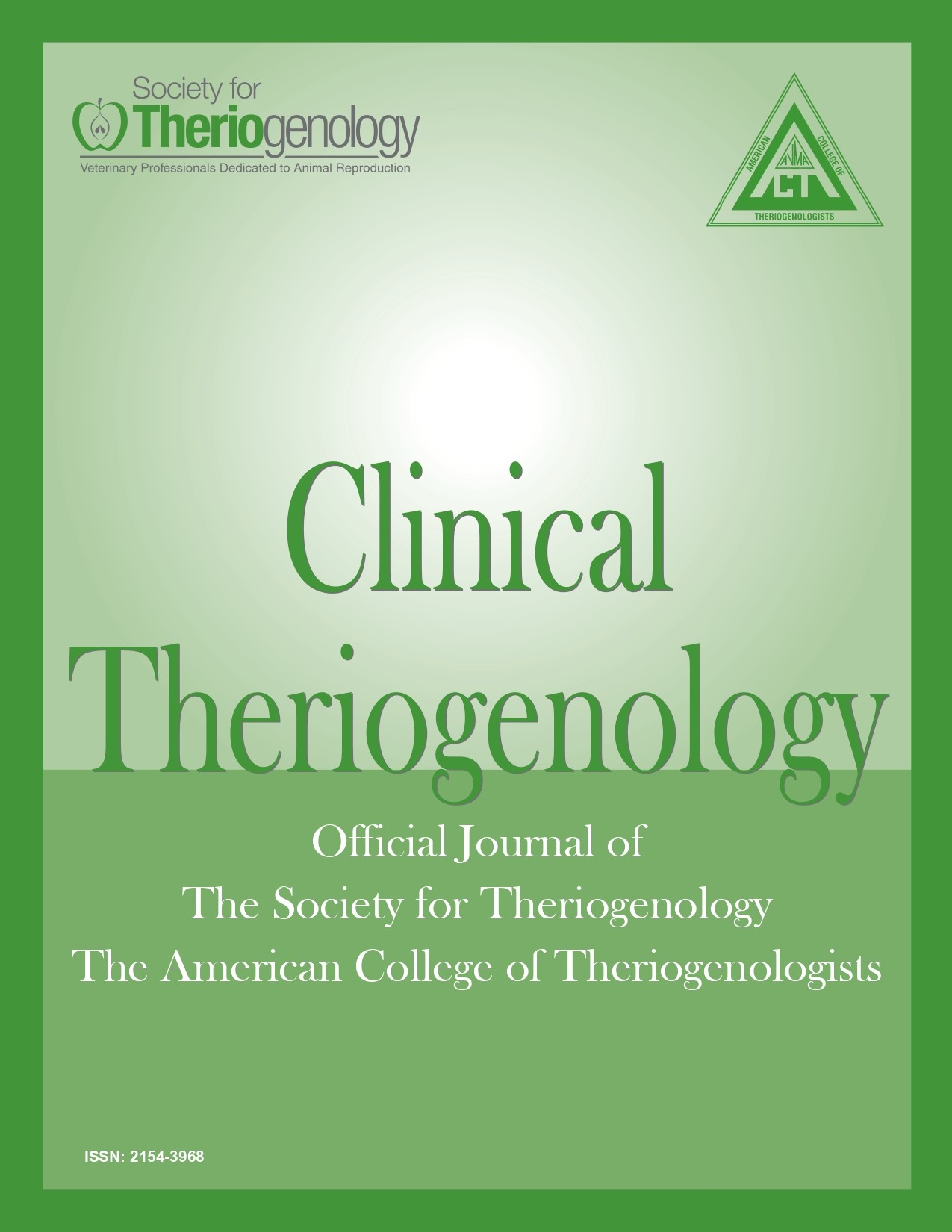Diagnosis of clinical cervicitis and vaginitis in dairy cows in relation to various postpartum uterine disorders
Abstract
There is poor agreement between clinical findings and results of diagnostic tests in postpartum uterine diseases that may be explained at least in part by the presence of inflammation and infection at sites other than the endometrium. It was hypothesized that clinical cervicitis and vaginitis are components of reproductive tract inflammatory disorders in postpartum dairy cows. A total of 61 postpartum dairy cows were enrolled in a nested case-control design. Periparturient disease occurrence in weeks 1 (1w), 3 (3w), and 5 (5w) postpartum were recorded. Clinical cervicitis was diagnosed in 36.0, 40.1, and 31.1% of cows in 1w, 3w, and 5w postpartum, respectively. Approximately 64% of cows with clinical endometritis in 5w postpartum also had clinical cervicitis (p ≤ 0.05). Prevalence of clinical and cytological vaginitis was 0% in 5w postpartum. Average days open: 110 for healthy cows and 117 for cows with clinical cervicitis (p ≤ 0.001), 145 for cows with clinical cervicitis and clinical endometritis (p < 0.005), and 199 for cows with clinical cervicitis and cytological endometritis (p < 0.001). Contrary to vaginitis, high prevalence of clinical cervicitis and its association with clinical endometritis and longer average days open suggested a substantial role of the condition in postpartum uterine diseases.
Downloads
References
2. Herath, S, Lily ST, Fisher DP, et al: Bacterial lipopolysaccharide induces an endocrine switch from prostaglandin F2α to prostaglandin E2 in bovine endometrium. Endocrinology 2009;150:1912-1920. doi: 10.1210/en.2008-1379
3. Carneiro LC, Cronin JG, Sheldon IM. Mechanisms linking bacterial infections of the bovine endometrium to disease and infertility. Reprod Biol 2016;16:1-7. doi: 10.1016/j.repbio.2015.12.002
4. Williams EJ, Fisher DP, Noakes DE, et al: The relationship between uterine pathogen growth density and ovarian function in the postpartum dairy cow. Theriogenology 2007;68:549-559. doi: 10.1016/j.theriogenology.2007.04.056
5. Williams EJ: Drivers of post-partum uterine disease in dairy cattle. Reprod Domest Anim 2013;48:53-58. doi: 10.1111/rda.12205
6. de Boer MW, LeBlanc SJ, Dubuc J, et al: Invited review: systematic review of diagnostic tests for reproductive-tract infection and inflammation in dairy cows. J Dairy Sci 2014;97:3983-3999. doi: 10.3168/jds.2013-7450
7. Wagener K, Gabler C, Drillich M: A review of the ongoing discussion about definition, diagnosis and pathomechanism of subclinical endometritis in dairy cows. Theriogenology 2017;94:21-30. doi: 10.1016/j.theriogenology.2017.02.005
8. Deguillaume L, Geffré A, Desquibet L, et al: Effect of endocervical inflammation on days to conception in dairy cows. J Dairy Sci 2012;95:1776-1783. doi: 10.3168/jds.2011-4602
9. Hartmann D, Rohkohl, Merbach S, et al: Prevalence of cervicitis in dairy cows and its effect on reproduction. Theriogenology 2016;85:247-253. doi: 10.1016/j.theriogenology.2015.09.029
10. Marrazzo JM, Weisenfeld HC, Murray PJ, et al: Risk factors for cervicitis among women with bacterial vaginosis. J Infect Dis 2006;193:617-624. doi: 10.1086/500149
11. Li M, Li L, Wang R, et al: Prevalence and risk factors for bacterial vaginosis and cervicitis among 511 female workers attending gynecological examination in Changchun, China. Taiwan. J Obstet Gynecol 2019;58:385-389. doi: 10.1016/j.tjog.2018.11.036
12. Tison N, Bouchard E, DesCôteaux, et al: Effectiveness of intrauterine treatment with cephapirin in dairy cows with purulent vaginal discharge. Theriogenology 2017;89:305-317. doi: 10.1016/j.theriogenology.2016.09.007
13. Giuliodori MJ, Magnasca RP, Becu-Villalobos, et al: Metritis in dairy cows: risk factors and reproductive performance. J Dairy Sci 2013;96:3621-3631. doi: 10.3168/jds.2012-5922
14. Sheldon IM, Williams EJ, Miller ANA, et al: Uterine diseases in cattle after parturition. Vet J 2008;176:115-121. doi: 10.1016/j.tvjl.2007.12.031
15. Madoz LV, Giuliodori MJ, Migliorisi AL: Endometrial cytology, biopsy, and bacteriology for the diagnosis of subclinical endometritis in grazing dairy cows. J Dairy Sci 2014;97:195-201.
16. Dohoo I, Martin W, Stryhn H: Veterinary epidemiology research. Prev Vet Med 2005;68:289-292.
17. Breeveld-Dwarkasing VNA, de Boer-Brouwer M, Te Koppele JM, et al: Regional differences in water content, collagen content, and collagen degradation in the cervix of nonpregnant cows. Biol Reprod 2003;69:1600-1607. doi: 10.1095/biolreprod.102.012443
18. Gautam G, Nakao T, Koike K, et al: Spontaneous recovery or persistence of postpartum endometritis and risk factors for its persistence in Holstein cows. Theriogenology 2010;73:168-179. doi: 10.1016/j.theriogenology.2009.08.010
19. Mortimer RG, Farin PW, Steven RD: Reproductive examination of the non-pregnant cows. In: Youngquist RS: editor. Current Therapy in Large Animal Theriogenology. Philadelphia, PA; WB Saunders: 2006. p. 268-275.
20. Dubuc J, Duffield TF, Leslie KE, et al: Risk factors for postpartum uterine diseases in dairy cows. J Dairy Sci. 2010;93:5764-5771. doi: 10.3168/jds.2010-3429
21. LeBlanc SJ, Duffield TF, Leslie KE, et al: Defining and diagnosing postpartum clinical endometritis and its impact on reproductive performance in dairy cows. J Dairy Sci 2002;85:2223-2236. doi: 10.3168/jds.S0022-0302(02)74302-6
22. LeBlanc SJ: Postpartum uterine disease and dairy herd reproductive performance: a review. Vet J. 2008;176:102-114. doi: 10.1016/j.tvjl.2007.12.019
23. Bicalho MLS, Santin T, Rodrigues MX, et al: Dynamics of the microbiota found in the vaginas of dairy cows during the transition period: associations with uterine diseases and reproductive outcome. J Dairy Sci 2017;100:3043-3058. doi: 10.3168/jds.2016-11623

This work is licensed under a Creative Commons Attribution-NonCommercial 4.0 International License.
Authors retain copyright of their work, with first publication rights granted to Clinical Theriogenology. Read more about copyright and licensing here.





